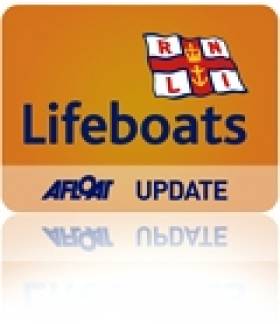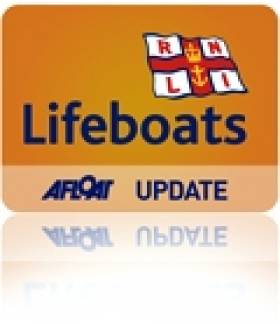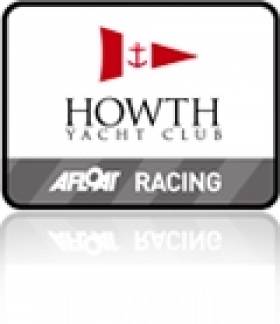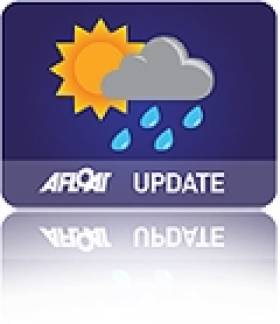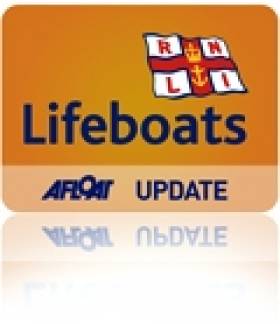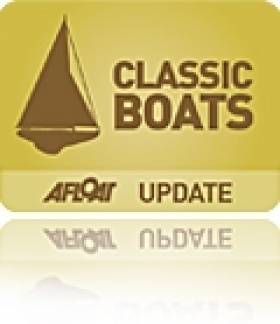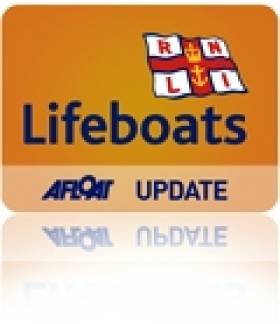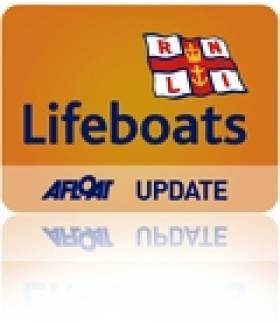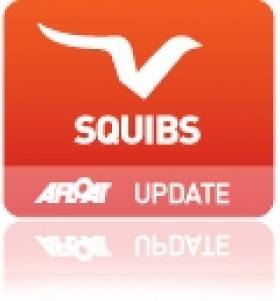Displaying items by tag: Howth
Howth Lifeboats Respond To Five Callouts In Five Days
#RNLI - Sunday's aid of a fishing trawler with a fouled propeller near Lambay Island was just one of five callouts or the volunteers at Howth RNLI within five days, marking one of the busiest seasons for the North Co Dublin crew.
These callouts were mainly to vessels that had developed problems while at sea and the lifeboats were called to assist and tow them to safety.
The first was on Saturday 9 August, when Howth’s inshore lifeboat was launched at 10.30am to locate and assist a motorboat that had started to take on water and was trying to make its way back to Howth Marina. The lifeboat crew escorted the vessel safely back to the harbour.
On Sunday evening, following the all-weather lifeboat's fishing trawler rescue previously reported on Afloat.ie, the inshore lifeboat was launched as darkness fell to assist a vessel which had run out of fuel outside Howth Harbour.
The motorboat, with three people aboard, was located and towed back to the public slipway where the motorboat had departed from earlier that day.
More recently, yesterday (Wednesday 13 August) the all-weather lifeboat launched at 1.40pm to tow a sailing vessel with steering problems back to the harbour.
The 43-foot sailing yacht, with three people aboard, was taken in tow and brought to Howth Marina.
Later in the evening, the all-weather lifeboat was again launched to assist a motorboat with engine problems to the north west of Ireland’s Eye. The vessel was quickly located and towed back to Howth Harbour.
“It has been a particularly busy time in Howth for both our lifeboats," said Howth RNLI volunteer lifeboat crew member David Howard, "but we are pleased that all our recent callouts resulted in no injury and all casualty vessels were safely towed back to Howth Harbour.
"All the vessels had means of contacting the shore and we compliment the skippers of the boats in not hesitating to call for help at the first sign of difficulties.”
Howth Lifeboat Tows Fishing Trawler To Safety
#RNLI - Howth RNLI's all-weather lifeboat launched at 1.20pm yesterday afternoon (10 August) to reports of a fishing trawler with a fouled propeller drifting north-east of Lambay Island.
Skerries RNLI's volunteer crew also launched their Atlantic 85 lifeboat Louis Simson, but were stood down when it became clear that Howth's Trent-class lifeboat was more apt for the job.
The Howth lifeboat crew located the casualty vessel at 2pm some 12 miles north-east of Howth and established a tow line within 10 minutes of arrival.
The fishing vessel was then safely towed back to Howth Harbour, though progress was slow as a result of deteriorating weather conditions – with a north-west Force 6 wind and a rough sea state – and the return journey took just over two hours.
Howth RNLI coxswain Fred Connolly said after the callout: "We were pleased to locate and assist the fishing trawler so quickly after receiving the call to launch.
"The fishing vessel crew acted very professionally in calling for assistance immediately and they also supplied a accurate position of their location which allowed us to find and assist them so quickly."
Gerry Canning, volunteer lifeboat press officer for Skerries RNLI, added: "The RNLI has a wide range of boats in the fleet to cater for all types of emergencies in all conditions. In this case the Trent all-weather lifeboat from Howth was definitely the right boat for the rescue."
Commodore's Yacht Wins Howth 17 Championships
#howth17 – The weekend's Howth 17 Footers Championships was won by Brian & Conor Turvey's 'Isobel'. Winning two of Saturday's four races and following a lengthy protest hearing between 'Deilginis' and 'Rita' (the latter then being disqualified from Race 2) afforded the Isobel team a victory by one point from Peter Courtney's 'Oona' with Ian Malcolm and crew of 'Aura' collecting their bronze medals for 3rd.
The event coverage included a first race aerial vid by Skypixels featuring the fleet (above).
Ian Sheridan's 'Erica' couldn't replicate their winning form from the previous evening, but were popular winners of the Handicap Trophy. Following praise for the Class Captain Mary Faherty and her running of the event, Commodore Brian Turvey thanked the race management team and their National Race Officer Scorie Walls for an excellent series, relaying particular thanks for the great work of the mark-laying teams following their swift action in the last race in managing a 60 degree wind direction shift.
Deluge Strikes Howth As Winds and Floods Wreak Havoc
#Weather - Heavy rain overnight has brought some severe flooding to Howth in North Dublin, as this photo taken by Robin Blandford (via Irish Weather News on Twitter) early this morning shows.
Strong winds from the tail end of Hurricane Bertha sweeping in from the Atlantic have destroyed the food village tent prepared for this afternoon's blessing of the boats.
The flooding is now easing as the weather system clears to the northeast across the Irish Sea.
But it was too late for the main road through Howth's village leading up to the summit which buckled under the strain of the floodwaters.
#asgard – The successful shipment of 1500 German-made Mauser rifles in 1914 by Erskine Childers and his associates in support of the Irish Volunteers and their defence of Home Rule was commemorated in a re-enactment yesterday at Howth attended by President Higgins. There were further ceremonies at Kilcoole in County Wicklow, where 600 of the rifles were later landed.
The 1905 Asgard, designed and built by Colin Archer in Norway to be a wedding present for Erskine Childers and his American bride Molly Osgood, is now conserved as a permanent exhibition at the National Museum in Collins Barracks. Yesterday, a modern ketch provided a useful stand-in for Asgard's most famous role in which – despite arriving in Howth on July 26th 1914 in a near-gale from the northwest – 900 rifles were quickly unloaded by the Volunteers and marched into Dublin.
It was only in the city centre at Bachelolors Walk that serious trouble erupted a hundred years ago, when British soldiers fired on a hostile crowd as the guns were being spirited away into hiding. The shots resulted in four civilian deaths, and their loss was mourned and honoured in yesterday's ceremonies.
The remarkable contribution by Erskine Childers and his family to Irish life for more than a hundred years was marked by the presence in Howth of Nessa Childers MEP and her brother Rory, the latter taking part personally in the re-enactment. President Higgins spoke movingly of the bravery of their grandparents in putting their lives at risk in taking action in support of a cause in which they passionately believed, their action playing a pivotal role in subsequent events.
The complexity of the gun running project became clear as the events surrounding it were outlined in Kilcoole. Originally, the 1500 guns were collected by Asgard and noted voyager Conor O'Brien's yacht Kelpie from a German tug with which they rendezvoused off the Belgian coast. Then while Asgard's entire cargo was sailed to Howth, most of the Kelpie's cargo was transferred off the Welsh coast to the 60ft yacht Chotah owned by the surgeon Sir Thomas Myles, who in his time was both the leader of the Irish Protestant Nationalist Association, and President of the Royal College of Surgeons.
{youtube}jVffT6thxxA{/youtube}
Chotah was brought into the project as it was felt her auxiliary engine would facilitate the landing straight onto the beach across St George's Channel channel at Kilcoole, where she was assisted by the McLaughlin family's fishing boat Nugget. In all, as an exercise in both gesture politics and guerilla activity, the mission was a remarkable success. But it paled into significance within days, as the outbreak of World War I swept events great and small aside. Many of those personally involved in the gun running were soon to see active service with the British forces, and Gordon Shephard, sailing shipmate and close friend of Erskine and Molly Childers for several years, and a leading figure in the Asgard episode in Howth, was to die on service as the youngest Brigadier in the British Army.
With Asgard now preserved as a national monument and never to sail again, several modern Asgard volunteers felt that an appropriately peaceful contribution would be to build a re-construction of Asgard's original little clinker-built sailing dinghy, as there are several photos of Erskine and Molly Childers in happier times with this little boat, which has long since disappeared. Thanks to basic drawings by Colin Archer, the boat could be exactly replicated, and lead organiser Pat Murphy and his team commissioned a reconstruction from boatbuilder Larry Archer (no relation), resulting in a new traditional boat which proved to be one of the stars of the show in Howth.
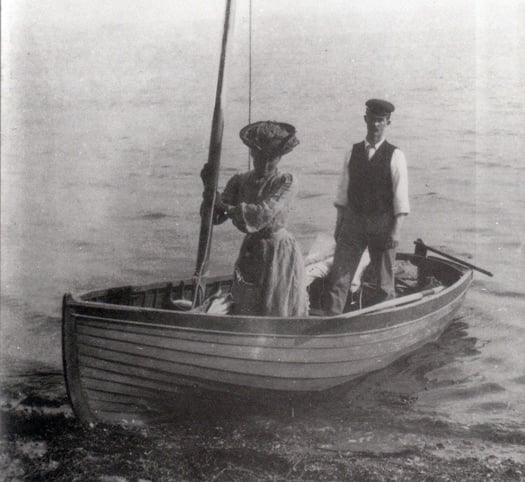
Happier days – Molly and Erskine Childers with the original Asgard dinghy
#rnli – Lifeboat crew at Howth RNLI launched their inshore lifeboat yesterday afternoon (Thursday 24 July) at 12.17pm following a call to the Coast Guard from a member of the public reporting that a boat with four people onboard was in trouble on the east side off Ireland's Eye, Howth. The 18ft vessel was taking on water.
Conditions were described as excellent and the lifeboat was on scene in minutes. The casualties had managed to leave their boat, which was beginning to become submerged and climb onto nearby rocks. The volunteer lifeboat crew immediately transferred the four people off the rocks and onto the lifeboat and put two of their own crew onto the stricken vessel to see if they could prevent it sinking. The inshore lifeboat returned to Howth harbour with the four people safely onboard and returned to the two lifeboat crew on the sinking vessel minutes later.
However the condition of the vessel had worsened and the two lifeboat crew onboard were unable to bail the water out. They had to quickly abandon the boat and swim the short distance back to shore as it had started to sink beneath them. The vessel was then quickly towed back to land due to a concern that it would cause a hazard if left abandoned in the area.
Commenting on the callout Howth RNLI lifeboat crewmember Ian Sheridan said; 'The good weather has brought an increase in the amount of people taking to the water. Thankfully conditions were calm and the four people involved in today's callout were all wearing personal floatation devices.
Before taking to the water there are things that people can do to ensure they stay safe or that can give them time if something goes wrong. They should always wear a lifejacket, carry a means of calling for assistance and check the engine and fuel before setting off. They should also tell others where they are going and what time they expect to return. In the event of an emergency on the water we would advise that people always dial 999 or 112 and ask for help.'
Programme Of Events For Asgard Centenary Commemoration
#Asgard - The official commemoration of the centenary of the landing of arms from the yacht Asgard at Howth and the subsequent loss of life at Bachelors Walk will take place on Sunday 27 July.
Descendants and relatives of the key participants will be guests of honour at these events, 100 years and a day after Erskine Childers' yacht delivered its cargo to the Irish Volunteers in their fight for home rule.
The programme begins with a wreath-laying ceremony at Glasnevin Cemetery at 9am, led by new Minister for Arts, Heritage and the Gaeltacht Heather Humphreys, in memory of the four members of the public shot at Bachelors Walk on Dublin's North Quays.
At 10am the Pro-Cathedral in Dublin city centre will hold a Mass in memory of the Bachelors Walk shooting victims, which will be attended by President Michael D Higgins.
The President will then join Minister Humphreys to address and lead the official commemoration ceremony by the Defence Forces at Howth Harbour's East Pier from 11.30am.
Following that, from 1pm the Asgard 100 Community Group will stage a re-enactment of the landing of arms, featuring a replica of the yacht Asgard and a flotilla of boats observed by President Higgins.
Local volunteers from the Howth GAA Club and marching volunteers from Dublin will unload and leave the pier with the consignment. Historical context to the events of 26 July 1914 will be provided by members of the Asgard 100 group throughout the proceedings.
Then at 1.30pm President Higgins will view the Asgard replica dinghy constructed by the Asgard 100 group and presented to the National Museum of Ireland (NMI).
The community element of the commemoration will continue after 2pm with a cultural programme featuring Brian Begley, Ceoltóirí Chluain Tarbh and St Brigid’s Pipe Band from Howth, which is free and open to the public.
Indeed, visitors are encouraged to attend in period costume, and prizes will be presented to the best period dressed individual male or female, family and boat crew.
Speaking at the presentation of the replica dinghy to the NMI, Minister Humphreys said: “I am very grateful to the volunteers of Howth for their generosity in giving their time and expertise to assist us to commemorate this important event in our history.
"There is no doubt that the landing of arms in Howth was a significant milestone along the road to Easter 1916 and I am delighted to support arrangements to mark this centenary in an appropriate way.”
Howth, Wicklow Lifeboats Aid Vessels With Engine Troubles
#RNLI - Howth RNLI continued a busy week of callouts on Wednesday evening (16 July) when the volunteer crew launched to assist a 27ft motorboat with no power drifting in the vicinity of the Nose of Howth.
The crew was alerted at 6.43pm following a distress call that a motorboat with two crew members aboard was drifting with no engine power at the mercy of the strong tide.
Weather conditions at the time were very good, with a light westerly Force 2 to 3 breeze and good visibility.
The Howth lifeboat, under coxswain Fred Connolly and with five other crew members on board, quickly located the casualty vessel and established a tow line to return the vessel and its occupants to the safety of Howth Harbour exactly an hour after the initial alert.
"The crew of the motorboat did the correct thing to call for help as soon as their vessel experienced engine trouble," said Connolly. "We are pleased that we were able to locate and tow the vessel to safety before it drifted closer to the shore."
Later that evening, Wicklow RNLI launched its all-weather lifeboat Annie Blaker to go to the aid of a 24ft yacht with mechanical problems off the Wicklow Coast.
The alarm was raised after the boat on passage south developed engine problems, With light wind, the yacht was unable to make any headway under sail, so the crew dropped anchor and contacted the Irish Coast Guard for assistance.
Wicklow's lifeboat, under the command of coxswain Nick Keogh, located the yacht – with two adults and a dog on board – one mile east of the Six Mile Point at 11.54pm. Conditions in the area were calm sea and light wind.
Crew member Kevin Rahill was transferred onto the yacht to establish a towline and assist the two sailors. Once the towline was rigged, the yacht was towed back to Wicklow Harbour, where it was safely secured alongside the East Pier by 1am.
Busy Three Days For Dublin Lifeboats In Howth & Skerries
#RNLI - Howth RNLI rescued a party of tourists yesterday afternoon (Monday 14 July) after the passenger boat they were on got into difficulty on the north side of Ireland’s Eye.
The volunteer lifeboat crew was alerted at 3.25pm following a Mayday call that a 30ft passenger boat had ran aground onto rocks and was taking on water.
Weather conditions at the time were described as good, with a westerly Force 2 to 3 wind blowing.
The lifeboat, under coxswain Fred Connolly and with four crew members on board, made its way to the scene a mile and a half away from Howth Harbour.
On arrival at the scene, Howth RNLI observed that another boat had come to the assistance of the casualty vessel and was holding it in position ready for the lifeboat to come alongside. It then emerged that the stricken vessel was not taking on water.
The lifeboat crew proceeded to transfer all of the tourists from the passenger boat safely onto the lifeboat, before establishing a tow line and returning the vessel and its occupants safely to Howth Harbour with no medical assistance required.
Further north in Co Dublin, Skerries RNLI were even busier in the weekend days before, responding to two separate callouts to vessels in difficulty.
Shortly before 5.30pm on Friday (11 July) the volunteer crew launched their Atlantic 85 lifeboat Louis Simson following reports of a small motor craft broken down off Donabate beach.
The lifeboat, with David Knight at the helm and crewed by Rob Morgan, Joe May and Eoin Grimes, proceeded directly to the area where they quickly located the motor craft with two people on board.
Conditions on scene were calm with a Force 2 southerly wind. A tow was established and the vessel was brought safely to Howth.
The second callout came shortly before 10.30am on Saturday (12 July) when Dublin Coast Guard requested Skerries RNLI launch to assist a yacht that had fouled its propeller North of St Patrick's Island off Skerries.
The lifeboat launched with David Knight on helm and Conor Walsh, Rob Morgan and Stephen Crowley also on board. There was a Force 1 northerly breeze at the time of launch and visibility was slightly reduced due to a misty rain.
The lifeboat quickly located the 13m yacht, which had fouled its propeller on a lobster pot. The volunteer crew managed to free the yacht and tow them safely to Skerries Harbour, where they then freed the remaining obstruction from the propeller.
Skerries RNLI's third launch of the weekend was less urgent but no less important, as the volunteer crew carried out their regular training exercises on Sunday morning (13 July).
Speaking of the callouts, Skerries RNLI volunteer lifeboat press officer Gerry Canning said: "It was a busy weekend but our volunteers are always ready and willing to drop whatever they are doing to help anyone that is in difficulty at sea."
#squib – The key to a successful cruise is good organisation. Plan ahead, select your destination, ensure that the tide is going in a favourable direction, ensure that the facilities at your place of arrival are adequate for your group of cruisers, and that the weather is fine writes Vincent Delany.
A Squib class event was conceived on 12th June after club racing, to cruise on the following Saturday to Howth, on the opposite side of Dublin Bay, on the expectation of a fish and chip lunch at Beshoff's famous fish shop, followed by a leisurely pint at Howth Yacht Club.
All did not go to plan.
There was a high pressure system sitting over the east coast of Ireland on Saturday morning with about 1 knot of wind from the north. It took the seven squibs, (Jill, Conor and Dermot in Perfection, Vincent and Joe in Femme Fatale, Gerry and Elena in Buzz Lite, Sheila and Gilly in Little Demon, Rupert and Emily in Sidewinder, Fergal and Wendy in Aija and Derek and Jean in Why Not) at least an hour to sail from the Royal St George Yacht Club to the Dun Laoghaire Harbour mouth. At that rate of progress they were guaranteed not to have a favourable tide all the way to Howth Harbour. What should they do? It was agreed to raft up and put the thinking hats on! Then a small breeze from the north east appeared. Somebody suggested "Let's go to Clontarf.", the Squibs were pointed in the direction of Poolbeg where two venerable lighthouses mark the entrance to Dublin Port. En route we sailed through hundreds of large racing yachts looking for wind, and when they found it, trying to get it to stay in a constant direction to allow a Bloomsday race to start.
When the first Squibs reached Poolbeg lighthouses, they waited for the others to catch up, before entering the Dublin Port area where Clontarf is on the north shore. The tide was almost full in so there was plenty of depth, except in a few areas which were inevitably unmarked. As the Clontarf fleet were our racing, some moorings were lifted and some anchors dropped in the shallow water. Yes we did know that the moorings dry out at low water. Next question was, how do we get ashore? A launch appeared from nowhere, welcomed us to Clontarf, an asked us where we had come from, and enquired if we wanted to go ashore. Some headed straight to Beshoffs (yes there are two branches of Beshoffs, on in Howth and one in Clontarf.) while others went straight to the Yacht club for refreshment. Peter Reilly asked us if we would like to see the O'Brien Kennedy designed IDRA 14 footer which is currently being built at the back of the clubhouse by the members. She was progressing well with at least half the planking complete. When we came back to the front of the clubhouse the 15 hungry Squibs we consuming huge platters of sandwiches which had been quickly made by Mrs. O'Rourke. It turned out that Clontarf is celebrating the 100 year centenary of another invasion, from the Vikings, so the Squibs were invited to don some Viking helmets.
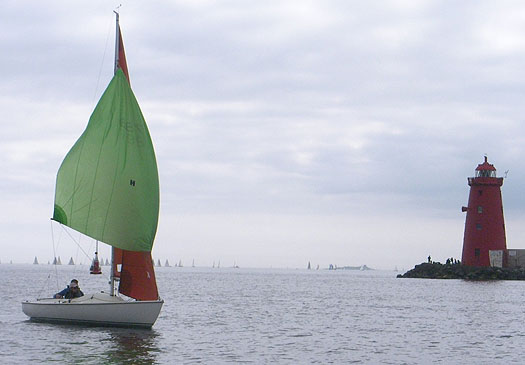
The Squibs make their way into Dublin Port
After about an hour of chat and gossip, it was time to check our boats in the falling tide. Yes they were all afloat with at least 300mm of water under the keels. An informal race was made out of the return trip, during which some Squibs were nearly run down by freighters entering Dublin Port. The light wind was from the south east, which meant that it was a beat all the way, but with a strong tide under us.
When only a few hundred yards from Dun Laoghaire harbour mouth, the wind disappeared entirely, so it was time to apply some paddle power.
In retrospect, spontaneity can be great fun. We should all spend more time cruising! .



























